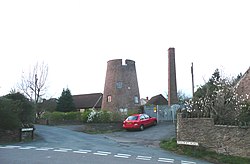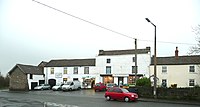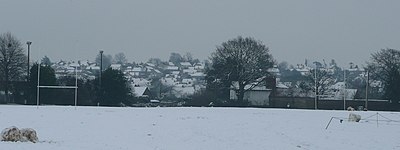Frampton Cotterell: Difference between revisions
Created page with "{{Infobox town |name=Frampton Cotterell |county=Gloucestershire |picture=Framptonmill.JPG |picture caption=Frampton Cotterell |os grid ref=ST670818 |latitude=51.54 |longitude=..." |
No edit summary |
||
| Line 2: | Line 2: | ||
|name=Frampton Cotterell | |name=Frampton Cotterell | ||
|county=Gloucestershire | |county=Gloucestershire | ||
|picture= | |picture=Framptonmill2.jpg | ||
|picture caption=Frampton Cotterell | |picture caption=Frampton Cotterell | ||
|os grid ref=ST670818 | |os grid ref=ST670818 | ||
| Line 23: | Line 23: | ||
==History== | ==History== | ||
===Roman age=== | ===Roman age=== | ||
[[File:Shops at Frampton | [[File:Shops at Frampton Cotterell2.jpg|left|thumb|200px|''Dullage'', believed to be the site of a Roman settlement]] | ||
Very little archaeological work has taken place in the Frampton Cotterell area so knowledge of the area prior to the Anglo-Saxon arrival is limited. Local historians tend to use field names and street names to work out the distant history of the village. It is believed from place names that there were two settlements in the area in the Roman times. One centred on the group of shops at the Church Road/Frampton End Road junction, where the name ''Dullage'' survived until the 1940s. The second was in rural farmland west of Cogmill in between Frampton Cotterell and [[Iron Acton]], here several fields held the name ''Chessolds'' from the old English 'ceastel' meaning 'a heap of stones'.<ref name=fc>'Frampton Cotterell and Coalpit Heath' by the Frampton Cotterell Local History Society (Tempus, 2007)</ref> | Very little archaeological work has taken place in the Frampton Cotterell area so knowledge of the area prior to the Anglo-Saxon arrival is limited. Local historians tend to use field names and street names to work out the distant history of the village. It is believed from place names that there were two settlements in the area in the Roman times. One centred on the group of shops at the Church Road/Frampton End Road junction, where the name ''Dullage'' survived until the 1940s. The second was in rural farmland west of Cogmill in between Frampton Cotterell and [[Iron Acton]], here several fields held the name ''Chessolds'' from the old English 'ceastel' meaning 'a heap of stones'.<ref name=fc>'Frampton Cotterell and Coalpit Heath' by the Frampton Cotterell Local History Society (Tempus, 2007)</ref> | ||
Latest revision as of 23:56, 24 November 2019
| Frampton Cotterell | |
| Gloucestershire | |
|---|---|
 Frampton Cotterell | |
| Location | |
| Grid reference: | ST670818 |
| Location: | 51°32’24"N, 2°28’48"W |
| Data | |
| Population: | 6,520 (2011) |
| Post town: | Bristol |
| Postcode: | BS36 |
| Dialling code: | 01454 |
| Local Government | |
| Council: | South Gloucestershire |
| Parliamentary constituency: |
Northavon |
Frampton Cotterell is a village in Gloucestershire, on the River Frome. The village is contiguous with Winterbourne to the south-west and Coalpit Heath to the east.
The parish borders Iron Acton to the north and Westerleigh to the south-east, the large town of Yate is half a mile away. The village is seven and a half miles north-east of the city of Bristol.
The village has evolved from a once rural Gloucestershire village, to a partial dormitory village for Bristol.
History
Roman age

Very little archaeological work has taken place in the Frampton Cotterell area so knowledge of the area prior to the Anglo-Saxon arrival is limited. Local historians tend to use field names and street names to work out the distant history of the village. It is believed from place names that there were two settlements in the area in the Roman times. One centred on the group of shops at the Church Road/Frampton End Road junction, where the name Dullage survived until the 1940s. The second was in rural farmland west of Cogmill in between Frampton Cotterell and Iron Acton, here several fields held the name Chessolds from the old English 'ceastel' meaning 'a heap of stones'.[1]
Anglo-Saxon and Mediæval history
The name Frampton means 'the settlement (farmstead or village) on the Frome'. Frampton Cotterell was recorded as Frantone in the Domesday Book (1086).
Early in the 11th century, Frampton may have been under the manor of Winterbourne, a later mediæval record refers to 'the Lordship of Frampton and Winterbourne'. This would have included Stoke Gifford. However, at no point after 1066 were these three manors owned by the same person. The name of a lane in the village, 'Harris Barton' also may be of pre-Norman origin, Barton comes from the Anglo-Saxon 'bere' and 'tun' meaning 'place where grain was stored' this suggests there was a farm here prior to Norman conquest.[1]
In 1086 Frampton was held by Walter the Crossbowman (Balistarius) and then contained 10 villagers and 11 smallholders. Indicating a total population of about 100, to this total should be added slaves and their families. In 1086 there was a church which was not there before 1066 (so under 20 years old) this church was probably on the site of St. Peter's church today. There were also two water mills, probably behind the church (near Mill Lane today) and at Cogmill.
By 1301 Frampton had a third watermill, probably at 'Frampton Lido' upstream from the church (where remains of a mill could be seen as late as the 1970s), a windmill, on the site of the current one at Brockeridge. and a coal pit, presumably at Coalpit Heath (although this name did not appear until around 1680)
By the 13th century the village was known as Frampton Cotell.[2][3] The name Cotell or Cotterell is derived from the Cotele Family, lords of Frampton Manor in the 12th and early 13th centuries. Their manor house was not at modern day Frampton Court, it was probably located behind the church on the east of Mill Lane, here the field names 'Hall Marsh' and 'Hall Marsh Mead' survived into the 19th Century.
The mediæval village was long and rectangular, located on the ridge between (Lower) Stone Close and the River Frome, and between Church Road and Rectory Road. The village was provided for using the open field system. Surrounding the village would have been three big fields; these fields were cultivated by peasants who held scattered strips in the many furlongs which made up the fields, every year one of the fields would be left unploughed and would be fertilised by the manure from the local animals. This system would have provided for the village.
Besides these fields there were also common wastes, Frampton Common, Adam's Land, Brockridge, Goose Green, Woodend Green, and Tovey's Green to name a few.
This system lasted until about 1550 by which time the big fields had made way for compact farms, cultivated by independent farmers as they saw fit. This boosted the village's economy, providing dairy products, cider, pigs, and turnips.[1]
Industrial era

During the 18th and 19th centuries, the hamlets of Brockridge, Adam's Land and others joined together with Frampton Cotterell to form the modern village. Since then the modern village has joined with Winterbourne, Watley's End and Coalpit Heath. One notable Industrial Revolution landmark in the village is the hat factory on Park Lane.
Frampton Cotterell Church of England Primary School was established on School Road in the village in the 19th century. It was moved to its present location on Rectory Road in the 1960s.
20th and 21st centuries
Ordnance Survey maps from the middle of the 20th century show open land between the three villages of Frampton Cotterell, Coalpit Heath and Winterbourne. Hamlets at Watley's End, Frampton End and Harris Barton,[4] all of which are now part of Frampton Cotterell and Winterbourne, were still separate at this time.
The most dramatic changes have occurred in the south-east of the village at the boundary with Coalpit Heath, in 1928 Beesmoor Road was constructed through farmland, connecting Badminton Road, the main Yate – Bristol thoroughfare, with the Woodend area of Frampton Cotterell. Since then estates of closes, drives and cul-de-sacs have been built up in the green land between Park Lane and Woodend Road.
In the 1960s Church Road, the main thoroughfare, was rerouted A field in between Rectory Road and Church Road called 'Benson's Field' was sold for housing becoming the 'Benson's Estate'. This estate comprises Beaufort Road, Foxe Road, Winchcombe Road and Brookside Close. Another field north of School Road was built on becoming Robel Avenue and Western Avenue. Houses on Heather Avenue and Beesmoor Road were built.
In 1996, an area of farmland to the south of the village was sold in a joint contract with housing estate developers Barratt and Taywood. In the years 1996–2000 they built a large housing estate known as Park Farm, adding an extra 200 3,4 and 5 bedroomed homes to the settlement. There was fierce opposition from local residents, particularly those living on Beesmoor Road. This followed another 20th-century housing development between Woodend Road and Beesmoor Road. In 2011 Barratt Homes began building another large estate on Denny's Field, alongside Park Farm and Heather Avenue, again despite fierce opposition from residents.
Cogmill
Cogmill is the name of a historical, and now almost non-existent hamlet in the north of Frampton Cotterell parish in South Gloucestershire. It is located on the B4058 between Frampton Cotterell and Iron Acton, and was possibly the site of a Roman settlement.
The name derives from the site of a watermill that was the originally recorded in the 1086 Doomsday census as "Cock Mill" and served as a mill for "Cock Mill Farm". The last known recording of this spelling was in the Appointment Roll of 1841 Tithe Map, from then on it has been known as Cogmill.
The watermill remained functioning until the early 19th century and was final demolished in 1958 by a compulsory purchase order by the local council, to eliminate a sharp corner on the B4058 road. Cogmill Farm still remains but the only evidence of the watermill is the remains of the tail-race tunnel and spill tunnel each side of the current river bridge. An article describing the mill was published by the Bristol Industrial Archaeological Society in 1981.[5]
In 2006 near the site of Cogmill, South Gloucestershire Council selected an area of land for a residential site for Gypsies and Travellers called Frampton Park.
In popular culture
Frampton is mentioned in the Monty Python sketch "Adolph Hitler lives In a guesthouse in Minehead".
Outside links
| ("Wikimedia Commons" has material about Cotterell Frampton Cotterell) |
References
- ↑ 1.0 1.1 1.2 'Frampton Cotterell and Coalpit Heath' by the Frampton Cotterell Local History Society (Tempus, 2007)
- ↑ ISBN 0-19-852758-6 Oxford Dictionary of British Place Names
- ↑ Plea Rolls of the Court of Common Pleas; National Archives; CP 40/677; Year: 1430; http://aalt.law.uh.edu/AALT1/H6/CP40no677/aCP40no677fronts/IMG_0637.htm; 4th entry; home of the defendant, Thomas Weston
- ↑ Ordnance Survey one-inch map of Great Britain, Sheet 156 Bristol and Stroud, Seventh series 1949, 1963 revision
- ↑ BIAS Journal, volume 13, page 2
